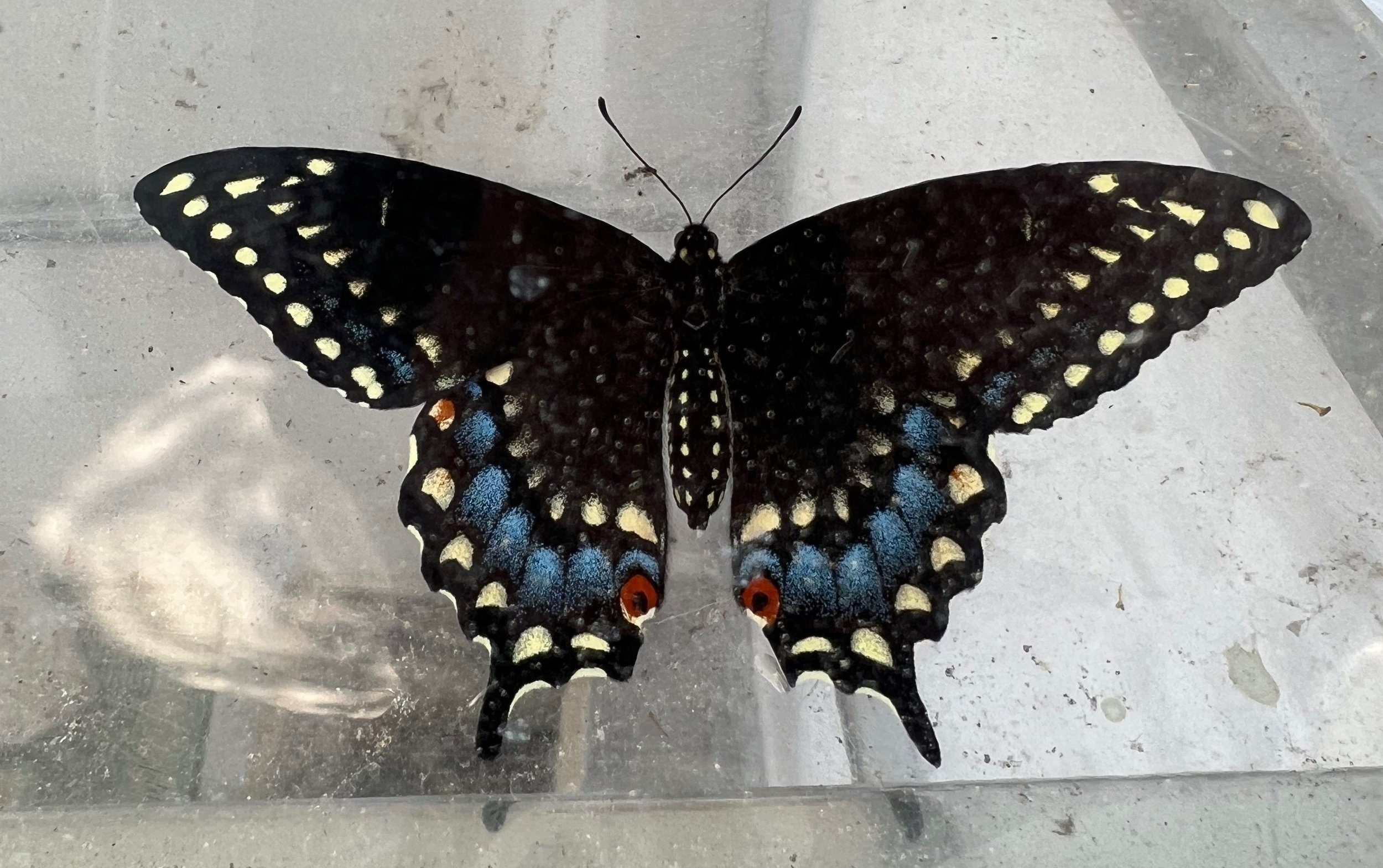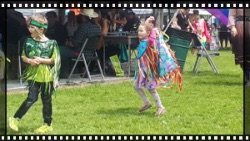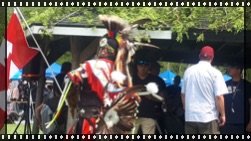Register for July 2023 Info Session
The newsletter is going on its annual summer holiday! This year it is a semi-holiday; if there is any news we feel you must know about in July or August, we will send out that information to keep you well informed. Look for our next full issue in September. Have a good summer!
Announcing…
Are you Cohousing curious? KCC keen? Peterborough probing? We have the answers for you! With our land acquisition almost complete, KCC is planning an information session online for anyone interested in exploring and joining our community. Save the date: July 6, 6:30-8:00pm. You can sign up here to reserve a space. Looking forward to meeting all of you!
Butterfly Babies
-Phil Aylesworth
Over the last few years, I've taken up a rather special hobby – raising Monarch butterflies right here in my backyard. These beautiful creatures are unfortunately facing tough times due to a loss of their natural habitat. Some folks have been helping out by planting milkweed, which is incredibly beneficial as it restores a breeding place for these butterflies. You see, the caterpillars feed solely on milkweed. Spotting eggs and young caterpillars, then raising them, also makes a difference as it safeguards them from predators and parasites, boosting their survival rates.
We've filled our garden with bee and butterfly friendly plants, so of course, we've got a lot of milkweed. As the name implies, it's quite a hardy grower and mostly takes care of itself. Our main task is just to pull out any plants that sprout up where they're not wanted! For our Black Swallowtail butterfly friends, we also plant parsley and rue. There have been times I left them be, only to later find them gone, so now I ensure they're safe and sound too. Last year, to my delight, I found a Giant Canadian Swallowtail butterfly caterpillar on our rue plant. They're not the most attractive, looking a bit like a bird dropping, but still a fascinating find!
While Monarchs fly south for the winter, other butterflies, like the Black Swallowtails and the Giant Canadian Swallowtail, choose to overwinter in their chrysalis form. By the end of last summer, I had two Black Swallowtails and a Giant Canadian to keep safe till spring. I put them in the garage, where it's cold enough to keep them in their chrysalis form, protected from any potential harm. Come early May, I brought them out into a screened enclosure in the yard. A couple of weeks later, one of the Black Swallowtails emerged, followed by the Giant and then the other Black Swallowtail. It's truly rewarding to watch them as they strengthen their wings for flight. Once they're ready and start to flutter, I let them fly free.
The entire process is quite miraculous, wouldn't you agree?
Delectable Dhal
-Sunil Kittur
Ingredients
1 cup toor dhal (see note 1)
Pinch of hing (asafoetida) powder (see note 2)
1/2 tsp turmeric powder
1 tsp cumin powder
1-2 tbsp tamarind pulp (see note 3)
1-2 tbsp vegetable oil or ghee
1/2 tsp mustard seeds
15-20 curry leaves
Pinch of jaggery or brown sugar
Salt to taste
Method
1. Rinse the dhal thoroughly and check for grit or other detritus.
2. Add about 5 cups of water to the dhal and bring it to a boil. You may need to skim off any foam that builds up to avoid the pan boiling over and making a mess.
3. Add the hing, turmeric and cumin powder.
4. Simmer for 30-45 minutes until it reaches the consistency you want. You can add water while it’s simmering to get the consistency you want.
5. Add the oil/ghee to a small frying pan and heat to medium hot.
6. Add the mustard seeds until they start popping (about 30 seconds or so).
7. As the mustard seed start popping, add the curry leaves and stir for just a few seconds until they crackle.
8. Pour the oil, seeds and leaves onto the dhal and stir it through.
9. Add the sugar and salt and simmer for a few minutes to bring all the flavours together.
You can jazz it up a bit more by adding a tarka (infused oil) of smashed/slices garlic or thinly sliced shallots:
1. Heat some oil in a small frying pan
2. Add garlic or shallots and stir over medium high heat until they are nicely golden brown, then pour onto the dhal.
Notes
1. If you can’t get toor dhal, yellow chana dhal works. You can also use red lentils but they are less flavourful.
2. Although it’s a robust aroma before cooking, hing does add an authentic touch to the dish, but you can leave it out if you are scared. It also helps lessen the “gassiness” from the lentils.
3. I use a block of dried tamarind: simmer with a couple of cups of water, mashing it down to a pulp. This takes a while. Once you’re bored of that, strain out the seeds and other stringy bits and put the pulp into an ice cube tray. I find one block makes 16 cubes that mean you can use 1-2 cubes in a recipe. If you don’t want to go through all that hassle, there are other tamarind solutions, such as substituting lemon juice, but they aren’t as good in my opinion.
A Weekend of Indigenous Learning
-Marg Holland
Eight members and a friend of KCC enjoyed connecting on the long weekend. We had a great opportunity to experience history through The Peterborough Museum and Archives. As an example, we saw 163-year-old birch bark baskets, woven with dyed porcupine quills into intricate patterns, well-preserved and under glass, that had been presented to the Prince of Wales from the Michi Saagiig people. He apparently considered them to be souvenirs rather than the nation-to-nation gift that they were meant to be. The next day bridged over to the Hiawatha Nation powwow, which was another opportunity to grow in understanding and acceptance.
Lyn, Judy, Stew and I started the day by attending the service at Hiawatha United Church; a perfect segue into the powwow, with a focus on understanding of the Hiawatha First Nation community.
Walking onto the grounds of the powwow, Judy, Lyn, Stew and I were greeted with an enthusiastic welcome. There were no fees for Elders and they had covered seating where you could set up your own chairs. Free admission was also offered for children. Erika and Zainab joined us later.
Attendees were requested to stand in recognition of Canada with native drumming and messages to the creator. The Master of Ceremonies came with a friendly presence and informative knowledge to share throughout. Official speakers shared valuable acknowledgments and comment on the activities and work involved in creating the powwow. The Elders, the leaders of the community, were recognized. Special mention was given to an individual who had fought for Canada in WWII. Children were given gifts for their contribution to the powwow.
The opening event took place with a circular parade of drummers and various performers. The Master of Ceremonies commented on the significance of various dancers, and the regalia of the native culture. The jingle dresses, consisting of numerous levels of metal bells, were worn on young and elderly. These dancers entertained us in the heat with gentle and steady dancing, smiling with pride in their heavy skirts. It was awesome to watch the skill of the 4 dancers who had traveled to take part in this Hiawatha Powwow.
Many vendors displayed the gifts of native crafts of beading, wood work, and leather work, to mention a few. One booth was offering opportunities for individual to learn the native language.
All in all, this was an enjoyable event where we were entertained and had opportunity to share with other cohousers. The one downer was that the fry bread and native taco line-ups were an hour long. We were nourished with our home-made lunches and a relaxed supper at Marty Moo's Restaurant.
Equity Member Interview… Pam Lootsteen
Ok here it is, finally. Your editor (Pam) has interviewed everyone who was willing, and is interviewing herself for this edition. Many have tried to persuade her otherwise, but she was adamant she would be the last one interviewed (for now). And, may I say, what a fascinating subject she has been.
Pam has a cousin who is very into family history and she has access to Geni, a family tree website. She was recently informed by this website that she is related to King Charles via a distantly-related cousin of her father: “Charles III, King of the United Kingdom is Leo Abraham Van Thijn’s fourth cousin once removed’s wife’s husband’s ex-wife’s father’s wife’s great nephew.” While not a royalist, Pam is not above using this; she sincerely hopes that she will now get the respect she so richly deserves.
Pam was born in Parry Sound to Dutch immigrant parents, who moved to Toronto when she was 2 years old. Her paternal grandfather was Jewish, her grandmother Christian; they let her father and uncle choose which religion they wanted. Her father decided he was Christian and her uncle decided he was Jewish, and converted. She therefore has family in Israel, where her uncle moved. Most of her father’s family was killed in Auschwitz, so these are the last of his living relatives.
Her maternal grandmother was a strong-willed woman who fell in love with a man whose wife was in an insane asylum and, in those days, he could not divorce her. So she lived with him without the benefit of marriage – very looked down on in those days. Her mother was born of that union and Pam can honestly say that her mother was a bastard. (Only in wedlock terms – she was a nice person!)
Pam is the third of four children, having an older brother (deceased), older sister and younger brother. As the third child and second girl, she was not given any special treatment. (Do you detect a note of bitterness here? I do.)
Pam went to the University of Toronto with the intention of becoming a lawyer, but got interested in psychology. In her third year she met a Waterloo engineering student, named Len, at a party that his best friend hosted in Toronto. They had grown up a large city block away from each other, but had never met. Their first dance was to “My Sharona” by The Knack, which they now consider to be “their” song. (You see? Romance isn't dead!) Eventually, they moved in together. That was roughly 40 years ago, and they have never married, citing that they want to see if it “works out”.
When Pam graduated, she went back to the University of Toronto looking for work. She ran into one of her former professors, a cognitive psychologist. “What did you get in my class?” he asked. “A”, she said, and was hired on the spot as his Research Officer.
Next, at the University of Toronto, she got a job as Client Liaison Officer to a group of Biomedical Statistics PhD students who provided support to medical doctors doing research. Now you would think that a biostats student would be nerdy with thick glasses, but far from it -- they were a super social, funny group and she hung out a lot with them. Pam remembers this as the “funnest” group she ever worked with.
Pam left that job to go travel for a year in (mostly) South East Asia, and will not mention the many countries visited, as that list appears in Len’s interview. Both of them turned 30 on that trip. They decided that every decade, they would take the time for a long trip. Turning 40 was a 3-month trip to the Middle East and Viet Nam. Turning 50 happened when they had a 10-year old son, so it was a week in NYC and a week in Puerto Vallarta. 60 happened in Tokyo and in Cuba.
After the year-long trip, Pam decided to go to Quebec City to L’Université Laval and study French as a second language. She stayed a year, had francophone roommates, and got work in the summer, so she was fairly immersed. However, that was a long time ago and she feels she has lost a lot of fluency, since she moved back to Toronto.
She then got an ESL teaching certificate and taught ESL classes for a year or so. She loved it, but the pay was not great, and Len wanted to start a business which takes time to be stable, so someone had to make money. She got a job as a Welfare Officer for the City of Toronto. The worst job she ever had; it isn’t a good system for the end-users and it isn’t good for the workers either. She stayed 3 years and should have left after the first. She stayed just until the mortgage on their first house was approved and then quit. They are still in the same house.
Next job was at the Ontario Science Centre as a Bilingual Science Communicator. Pam had lots of fun doing science demonstrations such as The Electricity Show, the Chemistry Show, the Laser Show, etc., all shows written by herself. She was seconded temporarily to Editorial to fill in for someone on leave, and wrote for them. She left the Science Centre to go travelling again. (I’m detecting a theme.)
Pam and Len adopted their son at 2 ½ years old. She wanted to stay home with him, and the easiest way to do that was to work for Len. He was drowning in admin anyway and needed the help. She continues to do that.
Pam has been a lifelong learner. She studied Gemmology. Len, as an amateur mineralogist, was horrified by this (“You murder the crystals!”). She knows American Sign Language, which she found fascinating – it is a complex, rich language. She studied at the Nalanda College of Buddhist studies, affiliated with U. of T. She did Vipassana meditation courses. She has done volunteer work at various organizations: the Canadian Centre for Victims of Torture, Médecins Sans Frontières (Doctors Without Borders), The Bob Rumball Centre for the Deaf (teaching deaf immigrants English and ASL) and a recently-built affordable housing building for homeless seniors.
Pam was put in special classes as a child as an advanced reader and she still loves to read. She bakes, having quite the sweet-tooth, and likes to cook. Or, rather, to eat; cooking just gets you there. (In fact, when travelling she tends to say, “Yeah, yeah nice temple; when’s lunch?”). She loves music. Before the pandemic, she was in a choir. She enjoys singing and will return to it. She has lots of plans to learn new things when she is retired.
Pam and Len found cohousing through a newspaper article on the subject and said immediately, “That’s for us.” They love the idea of community and living sustainably. Their son works in Toronto and they want a community that is not far from it. Besides, leaving Toronto is going to be something of an adjustment and they want to be able to return easily for visits.
Wise words
In the end we only regret the chances we didn't take.
We were born to make mistakes, not to fake perfection.
-John Zadelis
We would love to tell you more about ourselves and what cohousing can offer you.
Follow us on our Facebook page, Instagram account or connect at kawartha commons.ca








